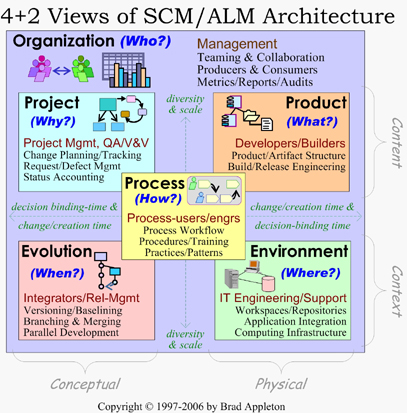If we take the 4+1views approach of Rational's Unified Process (RUP), which defines the critical architectural stakeholder "views" as: logical, physical (implementation), processing (processing & parallelism), deployment, and use-cases/scenarios, and if we enhance those with one more view, that of the organization itself, then we arrive at a Zachman-like set of RUP-compatible views for an SCM solution architecture that I call a "4+2" Model View of SCM Solution Architecture.
The "4+2" Model View of SCM Solution Architecture contains 6 different views, that I characterize as follows:
- 1. Project {Logical Change/Request Mgmt} -- e.g., change-requests, change-tasks, other CM "domain" abstractions and their inter-relationships, etc.)
- 2. Environment {Solution Deployment Environment} -- e.g., repositories, servers/networks, workspaces, application integration
- 3. Product {Physical/Implementation/Build} -- e.g., repository structure and organization, build-management scheme and structure/organization
- 4. Evolution {Change-Flow and Parallelism} -- e.g., tasks, codelines, branching and merging/propagation, labeling/tagging
- +1. Process {Contextual Scenarios/Use-cases} -- e.g., workflow, work processes, procedures and practices
- +2. Organization {Social/People Structures} -- e.g., organizational structure for CCBs, work-groups, sites, and their interactions, and corresponding organizational metrics/reports for accounting and tracing back to the value-chain. (Mario Moreira's "SCM Implementation" book has a great chapter or two on the importance of this and some best-practices for it)
The fact that many of the views closely align with RUP suggest that UML might be a very suitable diagramming notation for modeling such an architecture. And I think that much of the current best-practices of enterprise architecture, agility, object-oriented design principles, and service-oriented architectures apply to the creation of an agile CM environment that represents such a solution architecture.



No comments:
Post a Comment